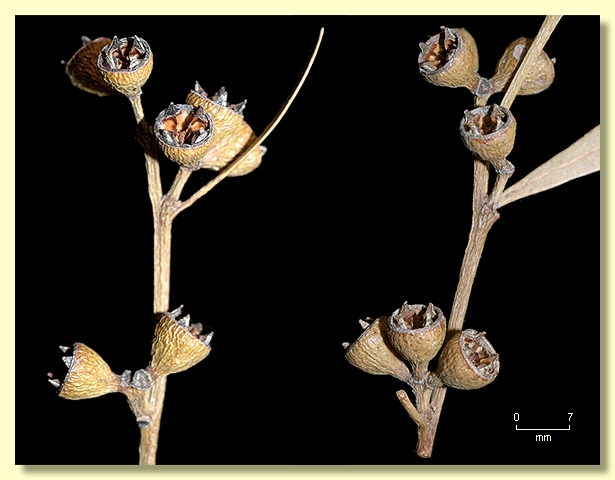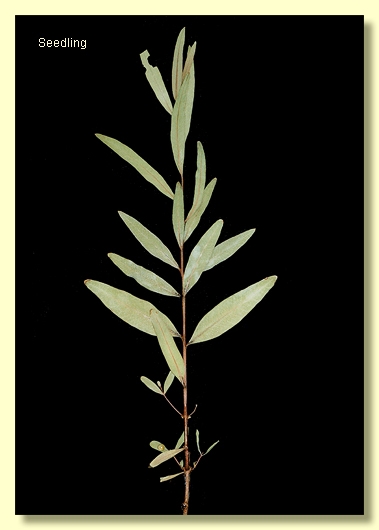Eucalyptus | Symphyomyrtus | Bisectae | Glandulosae | Accedentes
Euclid - Online edition
Eucalyptus baiophylla
Mallee 0.5 to 4 m tall, low plants forming thickets and may be procumbent. Forming a lignotuber.
Bark rough flaky grey-black, red-grey or grey-brown box-type on trunk often extending to branches 6 cm diameter, upper branches smooth-barked and grey to pinkish-grey or orange.
Branchlets have oil glands in the pith.
Juvenile growth (coppice or field seedlings to 50 cm): not seen.
Adult leaves alternate, petioles 0.3–1 cm long; blade linear to narrowly elliptical 4.7–9.8 cm long, 0.4–1 cm wide, base tapering to petiole, apex pointed or rounded and apiculate, concolorous, dull at first becoming glossy, green, side-veins at an acute or wider angle to midrib, reticulation sparse or obscure, intramarginal vein present and close to margin, oil glands scattered, island. or intersectional.
Inflorescence axillary single, peduncles (0.1)0.3–0.9 cm long, buds 7 or more commonly 9 per umbel, usually shortly pedicellate (pedicels 0–0.2 cm long). Mature buds obovoid to pyriform (0.8–1.3 cm long, 0.4–0.7 cm wide), rarely almost sessile, outer operculum shed very early in bud development, scar present but may be hard to see on mature buds, inner operculum rounded, stamens irregularly flexed or mostly inflexed and some irregular, anthers oblong, versatile, dehiscing by longitudinal slits (non-confluent), style long, stigma blunt or slightly dilated, locules usually 3 or 4, the ovules arranged in 4 vertical rows on the placentae. Flowers white.
Fruit sessile or more usually pedicellate, pedicels 0–0.3 cm long, obconical to more or less cupular, 0.5–0.9 cm long, 0.5–0.8(1) cm wide, disc descending vertically, valves 3 or 4, usually exserted.
Seeds dark brown to grey-brown, flattened-ovoid, 1.3–2.2 mm long, surface scarcely reticulate, hilum ventral.
Cultivated seedlings (measured at node 10): cotyledons bisected; stems more or less squared in cross-section, smooth or slightly warty, non-glaucous; leaves always shortly petiolate (petiole to 0.2 cm), opposite for ca 8 nodes then alternate, lower leaves narrowly elliptical becoming shortly and narrowly lanceolate or more commonly linear by node 10, 3.2-9 cm long, 0.3-0.6(1.0) cm wide, base tapering, apex more or less pointed, margin entire, green to green-blue, non-glaucous..
Flowering has been recorded in October.
A mallee species endemic to the Indian Ocean coast of Western Australia north from Quobba Point and Lake MacLeod to Giralia near Exmouth Gulf, occurring on red and white sandy or loamy soils with limestone gravel in the profile, on low level sites or low gravelly rises. Eucalyptus baiophylla has procumbent or erect habit, rough box-type bark, glossy green narrow adult leaves and obconical to cupular fruit.
Eucalyptus baiophylla is closely related to E. prominens and has only recently been split from it as a separate species. E. prominens is a mallee restricted to limestone sites of the Cape Range near Exmouth, sites with little soil and usually elevated (up to 300 m asl). It differs from E. baiophylla in having longer and wider adult leaves (4.7-9.8 cm long and 0.4-1.0 cm wide in E. baiophylla cf 8-14.5 cm long and 0.7-2.2 cm wide in E. prominens) and little or no rough bark. Another related Western Australian endemic species is E. zopherophloia which occurs from near Jurien north to Peron Peninsula at Shark Bay and has fruit with valves consistently at or below rim level and ovate seedling and juvenile leaves (valves always slightly to boldly exserted and juvenile leaves more or less linear in both E. baiophylla and E. prominens ). There are populations of low mallees on the Peron Peninsula which are probably E. baiophylla (rather than E. zopherophloia) but further investigation is needed, particularly the growing of seedlings to check leaf shape.
Eucalyptus baiophylla belongs to Eucalyptus subgenus Symphyomyrtus section Bisectae subsection Glandulosae because the cotyledons are bisected, buds have an operculum scar and the branchlets have oil glands in the pith. Within this subsection, E. baiophylla belongs to a small subgroup of nine species, series Accedentes, further characterised by having buds with mostly inflexed stamens or some irregularly flexed (never erect), ovules in four (rarely six) rows, seeds flattened ovoid and with scarcely reticulate surface, and seedling and juvenile leaves petiolate and opposite for few nodes. The nine species are the white smooth-barked trees E. accedens and E. laeliae, and the mallees E. baiophylla, E. leprophloia, E. trivalva, E. pruiniramis, E. zopherophloia, E. prominens and E. pilbarensis. All are Western Australian endemic species except the desert dwelling E. trivalva which extends to central Australia and South Australia.
Eucalyptus baiophylla: from the Greek words baios meaning small, and phyllon, a leaf, referring to the narrow and often shorter adult leaves compared with the related species E. prominens and E. zopherophloia.









